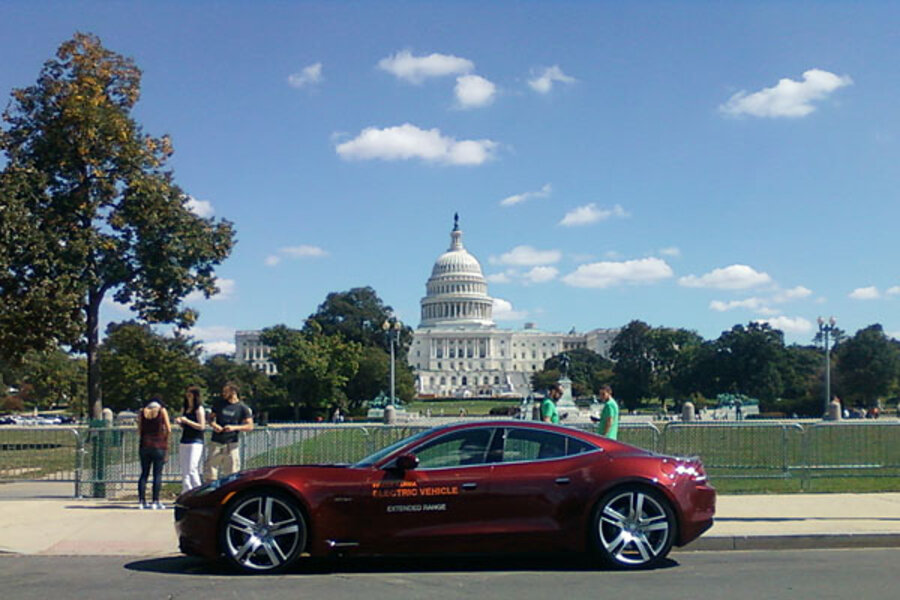National Plug In Day: Electric car fans push pedal to metal
Loading...
| Boston
It didn't generate as much attention as the Detroit auto show or, for that matter, a meeting of global oil ministers. But for fans of a technology that seemed on its death-bed a few years ago, National Plug In Day proved to be a powerful way to celebrate a remarkable recovery.
Owners of plug-in hybrid and all-electric cars gathered Sunday in 60 US cities – double last year's inaugural event – to mark the progress and draw new fans to the technology. In communities ranging from Ann Arbor, Mich., to Tucson, Ariz., to Portland, Ore., National Plug In Day offered vehicle test drives, “tailpipe-free tailgate parties” and at least one “silent and emission-free EV parade.”
It's a far cry from the situation a few years ago when activists were marching outside car dealerships to convince automakers to make plug-in cars.
“We’re so thrilled with the turnaround,” said Zan Dubin Scott, communications director for Plug In America, in a telephone interview. “In 2005, I was on a picket line, and today I’m driving an electric car.”
Due largely to rising gas prices, increased public awareness, and government subsidies, the number of electric vehicles on American roads more than quadrupled between 2000 and 2010, according to the US Energy Information Administration. When major auto companies began producing electric cars in 2010, the number of charging stations skyrocketed in response. Over the course of a year, the number of stations rose by 2,853 – a 527 percent increase –according to the EIA.
Although considerable hurdles remain for widespread acceptance, electric vehicles have driven an estimated 200 million miles on US roads, according to a study released this month by the Sierra Club, a San Francisco-based environmental organization which, along with Plug In America and the Electric Auto Association, organized this year’s event.
Here in Boston, representatives from Nissan, Ford, Toyota, Cadillac, and Mitsubishi showed off the latest models in Boston Common, and answered questions about cost, charge time, and range. Curious passersby peeked into propped-open hoods, eying space-age technology in place of the familiar gas engine.
Representatives from Benjamin Franklin Institute of Technology, a technical college located in Boston’s South End, were on hand to recruit students for their automotive technology program. In the past two years, the school has expanded its alternative fuel course offerings to keep up with a changing industry.
“We don’t want our students to be limited when looking for jobs,” said Marvin Loiseau, director of admissions at Benjamin Franklin. “Knowledge of alternative fuels allows them to be more marketable.”
Even plug-in advocates admit that there's a long road ahead before mainstream consumers latch on to electric vehicles, which have captured only 3 percent of the market, according to the Electric Drive Transportation Association.
For some, the new technology simply costs too much. A study released Friday by the Congressional Budget Office found that even with current tax credits of up to $7,500, electric car owners are likely to spend more than conventional vehicle owners over the lifetime of the car. The study also projects that tax credits and other federal policies used to promote the purchase of electric vehicles will cost taxpayers $7.5 billion through 2019.
Some also point to the high per-cost unit for electric vehicle manufacturers and less-than-expected sales numbers. The Chevy Volt, a plug-in hybrid vehicle, hit a record sales figure of 2,800 in August, but only after the car was discounted by 25 percent off its sticker price, the Washington Post reported.
Range anxiety – or the fear that the car’s battery will lose charge mid-trip – is another deterrent.
Advocates say this fear is purely psychological. A majority of trips made in the US are well within an electric vehicle’s range, advocates say, and most charging takes place overnight. Trips under six miles long make up 62 percent of all US vehicle trips, according to the EIA.
Pure electric vehicles are ideal for the city, said Nate Kulis, Internet sales manager for Colonial Nissan of Medford, Mass., showing off a white 2012 Nissan Leaf under the shade of trees in Boston Common. They are quiet, clean, cost-efficient and help reduce the country’s dependence on foreign oil. But it may take some time to convince the majority of Americans, he said.
“We’ve been using gasoline for 100 years,” Mr. Kulis said. “People are stuck in their ways.”







